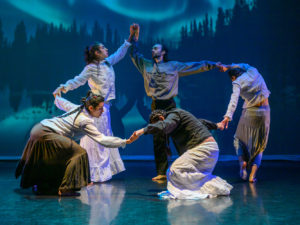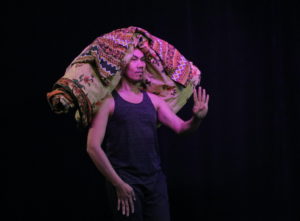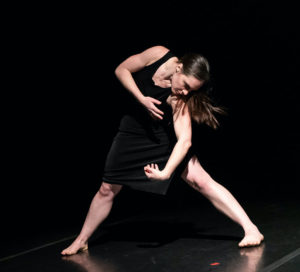Vancouver: Off and on the Edge - Vancouver Ballet Society
- Home
- City Reports 2020 - 2023
- Vancouver: Off and on the Edge

By Kaija Pepper
Yvonne Chartrand has been steadfastly bringing her welcoming vision to the stage through her small Vancouver company V’ni Dansi since 2000. The name translates as “Come and Dance” in Mitchif (the language spoken by the Métis) and this invitation to share is felt throughout her body of work. V’ni Dansi’s latest production, La Mitchin di Mitchif (Mitchif Medicines), at Scotiabank Dance Centre in June, carried Chartrand’s typical warmth.

La Mitchin di Mitchif is a co-production with a Santa Fe group led by Rulan Tangen, Dancing Earth. Co-choreographed by Chartrand and Tangen, the work is inspired by cultural ancestral knowledge of Métis plant medicines. Nature frames the piece — Gregory Coyes’ video of winter scenes opens; later, birds and plants fill the stage-width screen. The soundscape returns often to birds and water, with a powerful score from Métis composer Wayne Lavallee that seems to inspire the performers to sweep into full-body movement. Dancers included longtime members of V’ni Dansi Eloi Homier and Madelaine McCallum, and Tangen with three members of Dancing Earth. Chartrand was sidelined at the opening show I attended for reasons related to COVID.
Toward the end, I needed more context for the voice-over statement that knowledge of the plants’ medicinal values was “an intellectual property right given by the Creator” to the Métis, but sympathized with the plea that followed for land rights in order to protect the plants.
A few days later at the same black-box theatre, two visiting Finns — Maria Nurmela and Ville Oinonen — shared the stage for their intimate study of a variously evolving and devolving relationship in The Days, choreographed by England’s Theo Clinkard. Some sweet moments came during the last part, when a senior member of the audience rose and joined Nurmela onstage, a kind of future older self, followed by another, this time a man, Oinonen’s future self. Both guest performers were from the local arts community, not professional dancers but familiar with theatre conventions, adding a poignant real-world note about time and the passing days.

The 34th Dancing on the Edge Festival filled July with 10 days of contemporary dance, mostly at the Firehall Theatre. Of the seven works I saw, Raven Spirit Dance’s Confluence struck the most thoughtful, inviting note. With a long genesis that includes a work-in-progress showing at last year’s Edge [reviewed here], Confluence has a solid artistic lineage of dancers who made contributions to building its “somatic tapestry that speaks to the resilience of Indigenous women” (from the program note). Performed with quiet certainty, the five women onstage — including Raven Spirit’s founding artistic director Michelle Olsen (from the Tr’ondëk Hwëch’in First Nation) and co-artistic director Starr Muranko (of Cree, French and German ancestry) — create a calm and joyful space. The body is the vehicle, not the statement; the work’s inspiration and its physical manifestation in shape and rhythm comes from within.

It must be something about these unsettled times, but I also appreciated the calm centre of folding&unfolding by Co.ERASGA, a short work performed by artistic director and choreographer Alvin Erasga Tolentino, Marc Arboleda and Antonio Somera Jr. This piece, too, is informed by the artists’ cultural heritage, in this case Filipino: a Philippines traditional fabric, the multifunctional tubular malong, is the prop on which folding&unfolding is built. The trio of men wear the fabric, or toss it around. Even when tangling his feet in cloth, Somera manages to take off in flight, his dance super-powered and fully embodied. You get the sense he is glad to be there, moving through time and space in the intense atmosphere of a theatrical performance.
Also memorable were two fierce solos, both by women. First, Zab Maboungou in her Wamunzo, premiered in 2018. Montreal’s Maboungou, who in 2021 received a Governor General’s Performing Arts Award for Lifetime Artistic Achievement, has spent years of devotion to her craft, developing a vocabulary that moves her body as naturally as breath. That vocabulary is a serious one that in Wamunzo animates the stage with clear precise moves. She was like a puppet at times, sharply hinged at the elbows, hips and ankles, asserting rhythm and shape along with two drummers and a percussionist who filled the small Firehall Theatre with vibrant live music.

The other fierce solo was Bunker + Vault by Rebecca Margolick, a young Vancouver dance artist who has been based in New York for some time (she danced with Sidra Bell from 2012-2016, and is currently with UNA Productions). To a driving wash of music by Nils Frahm and Nathan Fake, the 35-minute solo takes Margolick through a series of short intense choreographic bursts. In a skin-tight, stretchy black dress, her arms and legs strike out with dramatic force.
The program noted the choreographic influence of archival research on New York’s Clara de Hirsch Home for Working Girls from 1899-1950, though that did not provide an obvious “in” to the work’s intentions. Those seemed to be about energy and shape in the abstracted way of modern dance, but perhaps there is a story — about bunkers and vaults? — to come in future.

